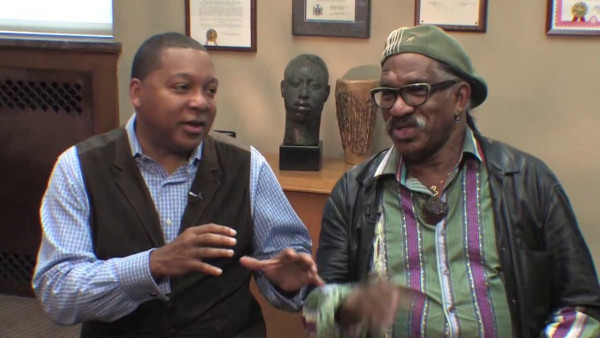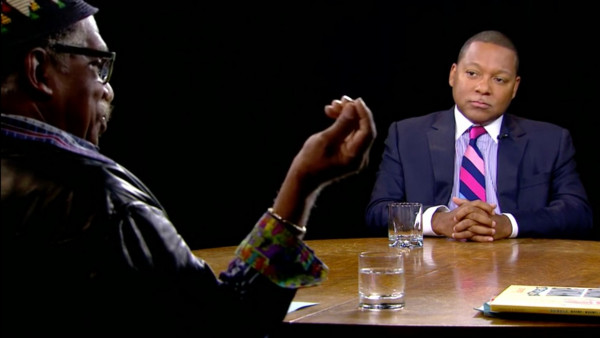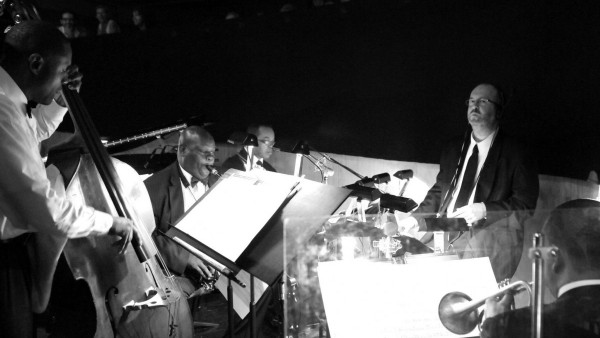Two Old Friends Prepare a Three-Part Premiere
ROCHESTER — Last week the jazz trumpeter and composer Wynton Marsalis walked into an office building here that once housed a Knights of Columbus chapter, rode an elevator to a high-ceilinged studio and discovered his septet, a 12-member modern dance company, a giant spatula and a 21-foot-tall woman.
Mr. Marsalis had a cold, but he wasn’t hallucinating. The studio is the home of Garth Fagan Dance, and Mr. Marsalis was there to rehearse. “Lighthouse/Lightning Rod,” his first collaboration with Mr. Fagan since “Griot New York” in 1991, opens at the Brooklyn Academy of Music on Thursday. The spatula was one of Martin Puryear’s set pieces for “Griot,” excerpts from which fill out the program in Brooklyn. The sculpture of the woman was a conception of a lighthouse by the artist Alison Saar.
In front of an enthusiastic audience of patrons and friends at a dress rehearsal later, Mr. Fagan described the three-part premiere: the “Lighthouse” opening and the “Lightning Rod” finale flanking a softer center based on memories that included his favorite part, what he described as “a sophisticated 21st-century ménage à trois.”
After a long day the men sat down to discuss their collaboration. Though Mr. Fagan, 72, and Mr. Marsalis, 50, are peers, there is a lot of father-son in their attitudes toward each other: a mixture of mutual praise, pride, easy humor and a little protectiveness. Here is an edited version of their conversation.
Q. How did you first meet?
GARTH FAGAN I heard Wynton play this amazing concert in Rochester. And then I was driving home and I saw him walking. Someone had left the band and he was upset about it. I know how it is when a dancer you love goes. I took him down to the studio. And my dancers did a command performance for him.
WYNTON MARSALIS I was 22, 23 at that time, and I was serious, but my seriousness was being tested. And he gave me a big boost. Not only him but everything he had created around him. It was moving.
Q. What about it?
MARSALIS Tonight, I was telling the cats in the band, these are people who have been with Garth for a long time. It’s a community. When I was growing up in Louisiana it was segregated, and a janitor made it possible for us to play basketball and football. With Garth tonight, it had that feeling. A community. He made it possible.
Q. The relationship grew?
FAGAN Yes. We catch his band wherever they’re playing. And they come see us. I’ve done other pieces to Wynton’s music since “Griot,” but he hasn’t done a commission for me since then.
Q. How did this one come about?
FAGAN I was bored. I wanted to see what would happen now that we’re both older. For “Griot” I gave him a poem. This time all I gave him was the title. I told him I needed something frisky to start, an adagio middle and a killer end. He gave me exactly that, nine pieces of music, and he said, “Do what you want with them.” I rearranged some, used one section twice. I knew from “Griot” that if something didn’t work, he’d change it on the spot.
Q. Wynton, did you compose with Garth in mind?
MARSALIS He teaches his dancers to listen to the underlying form. So with this piece I tried to make the form more intricate. One piece I made real complicated. I was kind of glad when he told me he didn’t like it, because it’s hard for us to play. But when we got here he said, “I put it in.”
FAGAN I was chicken. But then I thought, “Roll up your sleeves and do it.”
MARSALIS What’s most striking about Garth is how he provides a counterpoint to what we’re doing. And I know he’s going to embrace the 4/4 swing, whereas most dancers are afraid of it. It’s kind of ironic, because it’s the principal of American dance rhythms, but everybody got away from it. It allows you to lay ideas out longwise. I think Garth understands that rhythm better than anybody.
FAGAN I insist that the dancers dance with the music, not to the music. I do that with Brahms, too. That’s my thing.
Q. You said that you’re doing “real jazz dance.” What did you mean?
FAGAN Not the corny, kick-kick sense. It means giving a sense of improvisation. I’ve choreographed for ballet, but in this I don’t want grand ballet preparations. Take risk, with the rhythm especially. Go to that scary place. The jazz people and the real dance people, about 15 to 20 percent of the audience, they’ll get it.
Q. And it’s O.K. for the musicians to improvise?
FAGAN Within a certain form. We know the music, so we don’t get lost if we don’t hear a certain note. And jazz musicians get bored doing the same thing every time.
Q. What do you do when you receive the music?
FAGAN I’ve got to listen to it two million times, till I know it. I choreograph in silence. I give the dancers the movement and see if it holds up. And then I turn on the music and the dancers are so excited to see how it fits.
Q. Wynton, what’s it like to see your music choreographed?
MARSALIS We look at it one time, to see how Garth has laid it out. But he doesn’t want us looking at it too much, which is intelligent. Because we naturally will play something based on what they’re doing, and it’ll be like the counterpoint of a counterpoint. We’ll mess up the syncopation. If we’re looking at the dancers, we’ll start to play with them.
FAGAN Especially jazz musicians and female dancers.
MARSALIS But I have so much confidence in him. For those who have that absolute dedication, you always know the other people who have it. Look at how he is. He’s been working all day and he’s so excited.
FAGAN We know each other. Four members of the band did “Griot.” Both of our groups are like families. The age range of our company is 60 to 19. It’s a community onstage, not six little maids in a row. We have the pluses and the minuses of families.
MARSALIS Us, too.
Source: New York Times




Comments
Howdy very nice website!!
Bruce Oliver on Sep 29th, 2012 at 7:55am